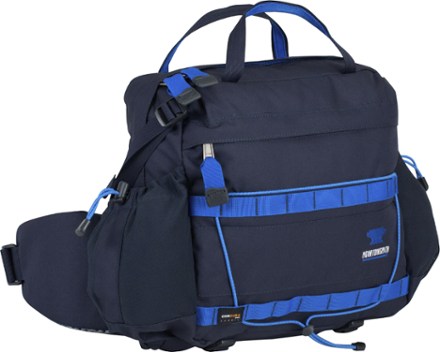
Best Lumbar Packs For Female Hikers:
Ten Tips For Choosing One
Plus Recommendations
By Diane Spicer
You say lumbar packs, I say fanny packs.
How about we agree on waist packs?
You know, a smaller version of a hiking backpack that goes around your middle and carries water, snacks and your jacket.
Here's why I prefer to call them "lumbar" packs
All 3 words (lumbar, waist, fanny) refer to a general anatomical area on a female hiker's body.
But there are 3 good reasons why I prefer the term "lumbar packs".
First off, I teach anatomy classes. I'd much prefer my students referring to their lower back side as the lumbar area, as opposed to their fanny.
Secondly, the term "waist" is too general for me.
Why?
I'm a retired naprapath, someone who specializes in the care of the spine.
I'm concerned with the way the lumbar pack is interacting with the lumbar vertebrae, as well as all points north and south on a hiker's body.
- So the other words are too general.
And just for the record, I have a third reason:
As a child, I was threatened with having my fanny whooped if I misbehaved. So the word has a very negative connotation for me.
- Just a personal preference to avoid it, but I'm sure you can sympathize.
Load bearing and the human spine
OK, so let's get down to it.
(Oh dear. I sense the onslaught of some rather pathetic puns. I will do my best to practice "pun avoidance behavior.")
The lumbar region of your spine is critically important to your hiking career.
There's a lot going on in that particular area of the body that can:
- make you miserable (via chronic lower back pain),
- set you up for problems later in life, such as chronic muscle tension,
- or sideline you temporarily (an improperly loaded lumbar pack can create lopsided muscle fatigue, leading to spasms).
A quick peek at the human spine should convince you that it really isn't designed for walking upright against gravity while bearing a heavy load.
Take a look at this diagram of your spine.
- Notice right away the curvatures: one near your neck and one near your gluteals (OK, I suppose the word "fanny" wouldn't hurt here).
That second curve is in the lumbar region.
And it's the lumbar region that will interact directly with the lumbar pack.
[As an aside, you might want to check out the association between tight muscles on the back of your legs and lower back pain, nicely explained just below the diagram you looked at.]
Who should wear a lumbar pack?
Dayhikers who don't want to bring lots of hiking gear can get away with a lumbar pack, especially one that has room for the ten essentials.
Anyone training for a backpacking trip can begin their daily walking regime by wearing this type of pack, carrying water and snacks until they feel ready to switch to a loaded backpack.
Hikers with chronic back and neck problems should consider using a lumbar pack, because it distributes weight across the pelvis and avoids over stressing the spine and shoulders.
Kids who hike love having these little packs on, because there are places to stash snacks and treasures found on the trail (pine cones, feathers, you know!).
- They will also have handy access to a water bottle, eliminating the need to keep asking for water.
Ten tips: how to select the best waist pack for you
Here are a few ideas to keep in mind if you want to try wearing this small alternative to a hiking backpack:
What is the purpose of this pack?
If you just want to carry a water bottle (or 2) and some lip balm, or maybe a lightweight jacket, then you're correct in thinking that a day pack is overkill.
However, if you find yourself loading up the lumbar pack with snacks, keys, camera, lots of water, and other heavy items, do your back muscles a favor and DON'T use a waist pack.
- Think a little bigger.
Balancing act
Regardless of whether you have pockets for one water bottle or two, think "balance" every time you strap on the pack.
Don't make one side of your body work harder than the other.
Short term, no worries.
- Long term - ouch!
Be sure it fits you
How can you tell if the lumbar pack fits you?
- Can you tighten down and loosen the pack as needed? It should fit snugly at your waist, sitting on your hips.
- Does the pack have a wide enough range of belt material to fit you comfortably? Look at the specs for the adjustment ranges before you order one online.
- If you're trying it on "real time", play around with
the adjustment straps until you're convinced you've found the ideal
lumbar pack for your waist.
And please avoid having the waist belt dig into you for extended periods of time on the trail.
Not only is it annoying, it cuts off blood flow to important structures below the pack.
Like your leg muscles!!
Materials matter
Look for wicking and breathable materials in the waist belt. No sense in having your perspiration pool around your middle!
And while
you're at it, look for a little padding, too. You're wearing this pack right above your pelvic bones, where rubbing and chafing can occur.
Compatible water bottles, please
Be sure the water bottles that come with the pack play nicely with your lumbar area. Some bottles have a flat side so they snug up against you, giving a nice fit.
Some packs don't come with water bottles, so be sure your current bottles are compatible with the pack.
Go green
Interested in the "green" movement?
Some fanny packs are made from reclaimed or recycled materials.
Check under the manufacturer's specs for the source materials.
If every hiker reduces her carbon foot print, think about what a positive impact that will have on our treasured hiking destinations!
Look for some nice features
Any of these are useful:
- key clip
- compression straps
- shoulder straps
- bottom drain holes
- reflective strips
- zippered inner pockets to hold small treasures
Borrow one first
Try to borrow one of these fanny packs and give it a spin before committing to one particular manufacturer.
It's not that they are expensive.
- It's the time investment in equipment that doesn't work for you that I'm concerned about.
Or at the very least, don't be too shy to ask someone on the trail how they like their waist pack.
Hiking For Her's recommendations and reviews
for the best lumbar packs
Shop around
REI Co-op has an excellent selection of lumbar packs, with honest customer reviews and technical specifications on top brands so you'll know exactly what you're buying.
Here's a review of their Trail 5 waistpack.
Here is my top recommendation for a lumbar pack which provides comfortable trail time.
 Mountainsmith Day Lumbar Pack | REI Co-op
Mountainsmith Day Lumbar Pack | REI Co-op
I like this pack because it's built of tough materials, and it's got versatility with panels and pockets, meaning you'll get more mileage out of it (literally).
More to love for your money:
- You can press this bag into service as a secondary bag when you travel.
- Reputable brand, too!
Even more to choose from if you're shopping for lumbar packs
You never know when you'll see THE fanny pack or hip pack to make your eyes light up.
- Here are more than you can shake a stick at (so to speak).
All set to pick one out?
That about covers it! (See? I didn't even touch that easy hiking pun.)
As a hiker, you should be all about protecting your knees and back.
And now you know how!
Make room in your hiking gear locker for one of these sweet little ultra-portable and versatile packs, and never say "sorry" to your back muscles again.
Home page > Best Hiking Gear >
Best Hiking Lumbar Packs


